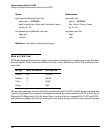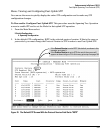
150
Enhancements in Release F.02.11
Fast-Uplink Spanning Tree Protocol (STP)
When single-instance spanning tree (STP) is running in a network and a forwarding port goes down,
a blocked port typically requires a period of
(2 x (forward delay) + link down detection)
to transition to forwarding. In a normal spanning tree environment, this transition is usually 30
seconds (with the
Forward Delay parameter set to its default of 15 seconds). However, by using the fast-
uplink spanning tree feature, a port on a Switch 2512 or 2524 used as an edge switch can make this
transition in as little as ten seconds. (In an STP environment, an edge switch is a switch that is
connected only to switches that are closer to the STP root switch than the edge switch itself, as shown
by switch "4" in figure 68, below.)
Figure 68. Example of an Edge Switch in a Topology Configured for STP Fast Uplink
In figure 68, STP is enabled and in its default configuration on all switches, unless otherwise indicated
in table 11, below:
Table 11. STP Parameter Settings for Figure 68
With the above-indicated topology and configuration:
■ Scenario 1: If the link between switches "4" and "2" goes down, then the link between
switches "4" and "3" will begin forwarding in as little as ten seconds.
■ Scenario 2: If Switch "1" fails, then:
• Switch "2" becomes the root switch.
• The link between Switch "3" and Switch "2" begins forwarding.
• The link between Switch "2" and the LAN begins forwarding.
STP Parameter Switch "1" Switch "2" Switch "3" Switch "4"
Switch Priority 0
1
1
2
32,768 (default) 32,768 (default)
(Fast) Uplink No No No Ports 3 & 5
1
This setting ensures that Switch "1" will be the primary root switch for STP in figure 68.
2
This setting ensures that Switch "2" will be the backup root switch for STP in figure 68.
Switch 4
(2512-Edge)
Switch 3
Switch 1
(Root)
Switch 2
Port 3
Port 5
Link blocked by STP:
1
6
8
LAN


















